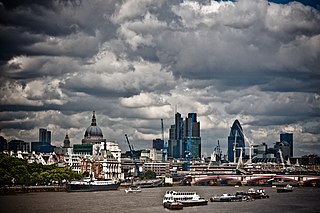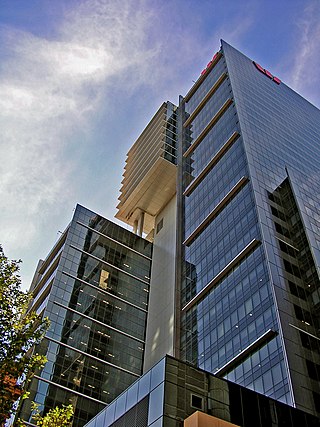
Liquidation is the process in accounting by which a company is brought to an end in Canada, United Kingdom, United States, Ireland, Australia, New Zealand, Italy, and many other countries. The assets and property of the company are redistributed. Liquidation is also sometimes referred to as winding-up or dissolution, although dissolution technically refers to the last stage of liquidation. The process of liquidation also arises when customs, an authority or agency in a country responsible for collecting and safeguarding customs duties, determines the final computation or ascertainment of the duties or drawback accruing on an entry.
In finance, a floating charge is a security interest over a fund of changing assets of a company or other legal person. Unlike a fixed charge, which is created over ascertained and definite property, a floating charge is created over property of an ambulatory and shifting nature, such as receivables and stock.

Salomon v A Salomon & Co Ltd[1896] UKHL 1, [1897] AC 22 is a landmark UK company law case. The effect of the House of Lords' unanimous ruling was to uphold firmly the doctrine of corporate personality, as set out in the Companies Act 1862, so that creditors of an insolvent company could not sue the company's shareholders for payment of outstanding debts.
Wrongful trading is a type of civil wrong found in UK insolvency law, under Section 214 Insolvency Act 1986. It was introduced to enable contributions to be obtained for the benefit of creditors from those responsible for mismanagement of the insolvent company. Under Australian insolvency law the equivalent concept is called "insolvent trading".
In law, a voidable floating charge refers to a floating charge entered into shortly prior to the company going into liquidation which is void or unenforceable in whole or in part under applicable insolvency legislation.
As a legal concept, administration is a procedure under the insolvency laws of a number of common law jurisdictions, similar to bankruptcy in the United States. It functions as a rescue mechanism for insolvent entities and allows them to carry on running their business. The process – in the United Kingdom colloquially called being "under administration" – is an alternative to liquidation or may be a precursor to it. Administration is commenced by an administration order.

Re Spectrum Plus Ltd[2005] UKHL 41 was a UK company law decision of House of Lords that settled a number of outstanding legal issues relating to floating charges and recharacterisation risk under the English common law. However, the House of Lords also discussed the power of the court to make rulings as to the law that were "prospective only" to mitigate potential harshness when issuing a ruling that was different from what the law had previously been understood to be.

United Kingdom insolvency law regulates companies in the United Kingdom which are unable to repay their debts. While UK bankruptcy law concerns the rules for natural persons, the term insolvency is generally used for companies formed under the Companies Act 2006. Insolvency means being unable to pay debts. Since the Cork Report of 1982, the modern policy of UK insolvency law has been to attempt to rescue a company that is in difficulty, to minimise losses and fairly distribute the burdens between the community, employees, creditors and other stakeholders that result from enterprise failure. If a company cannot be saved it is liquidated, meaning that the assets are sold off to repay creditors according to their priority. The main sources of law include the Insolvency Act 1986, the Insolvency Rules 1986, the Company Directors Disqualification Act 1986, the Employment Rights Act 1996 Part XII, the EU Insolvency Regulation, and case law. Numerous other Acts, statutory instruments and cases relating to labour, banking, property and conflicts of laws also shape the subject.

Re Barleycorn Enterprises Ltd [1970] Ch 465 is a UK insolvency law case, concerning the priority of creditors in a company winding up. It was held that fees for liquidation came in priority to preferential claims and floating charges. This was overturned by the House of Lords in Buchler v Talbot, but reinstated by Parliament through an amendment to the Insolvency Act 1986 s 176ZA.

Agnew v Commissioners of Inland Revenue, more commonly referred to as Re Brumark Investments Ltd[2001] UKPC 28 is a decision of the Privy Council relating to New Zealand and UK insolvency law, concerning the taking of a security interest over a company's assets, the proper characterisation of a floating charge, and the priority of creditors in a company winding-up.

Re Parkes Garage (Swadlincote) Ltd [1929] 1 Ch 139 is a leading UK insolvency law case, concerning a voidable floating charge for past value.

Re Anglo-Austrian Printing & Publishing Union [1895] 2 Ch 891 is a UK insolvency law and company law case, concerning recovery of assets under a misfeasance action. It was held that because the claims were vested in the company before the company went into liquidation, the proceeds of such a claim would be caught by a floating charge where the floating charge was expressed to include any after-acquired property.
Administration in United Kingdom law is the main kind of procedure in UK insolvency law when a company is unable to pay its debts. The management of the company is usually replaced by an insolvency practitioner whose statutory duty is to rescue the company, save the business, or get the best result possible. It is the equivalent of Chapter 11, Title 11, United States Code, although with significant differences. While creditors with a security interest over all a company's assets could control the procedure previously through receivership, the Enterprise Act 2002 made administration the main procedure.

Cayman Islands bankruptcy law is principally codified in five statutes and statutory instruments:

Re Brightlife Ltd [1987] 1 Ch 200 is a UK insolvency law case, concerning the conversion of a floating charge into a fixed charge ("crystallisation"). It held that an automatic crystallisation clause was part of the parties’ freedom of contract. It could not be limited by court created public policy exceptions. The significance of the case was largely outpaced by the Insolvency Act 1986 section 251, which said a floating charge was one that was created as a floating charge.
Australian insolvency law regulates the position of companies which are in financial distress and are unable to pay or provide for all of their debts or other obligations, and matters ancillary to and arising from financial distress. The law in this area is principally governed by the Corporations Act 2001. Under Australian law, the term insolvency is usually used with reference to companies, and bankruptcy is used in relation to individuals. Insolvency law in Australia tries to seek an equitable balance between the competing interests of debtors, creditors and the wider community when debtors are unable to meet their financial obligations. The aim of the legislative provisions is to provide:

Hong Kong insolvency law regulates the position of companies which are in financial distress and are unable to pay or provide for all of their debts or other obligations, and matters ancillary to and arising from financial distress. The law in this area is now primarily governed by the Companies Ordinance and the Companies Rules. Prior to 2012 Cap 32 was called the Companies Ordinance, but when the Companies Ordinance came into force in 2014, most of the provisions of Cap 32 were repealed except for the provisions relating to insolvency, which were retained and the statute was renamed to reflect its new principal focus.

Ayerst v C&K (Construction) Ltd [1976] AC 167 was a decision of the House of Lords relating to revenue law and insolvency law which confirmed that where a company goes into insolvent liquidation it ceases to be the beneficial owner of its assets, and the liquidator holds those assets on a special "statutory trust" for the company's creditors.

Re MC Bacon Ltd [1991] Ch 127 is a UK insolvency law case relating specifically to the recovery the legal costs of the liquidator in relation to an application to set aside a floating charge as an unfair preference.

Re Yagerphone Ltd [1935] 1 Ch 392 was a United Kingdom insolvency law decision relating to unfair preferences and the proceeds of any claims by a liquidator for unfair preferences, and in particular determining the priority of claims between the general body of creditors and the holder of a floating charge.














